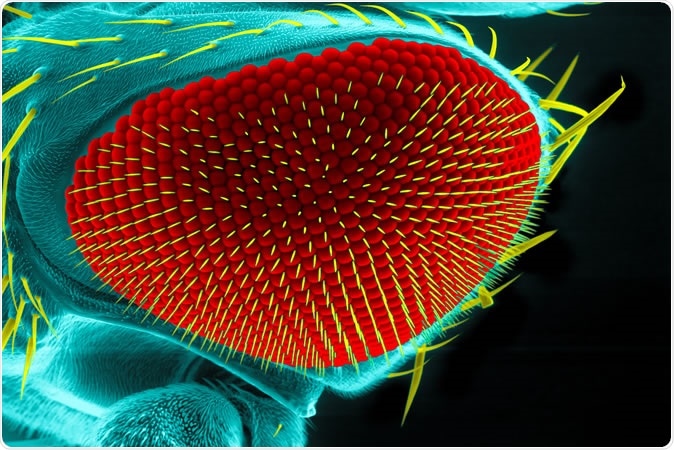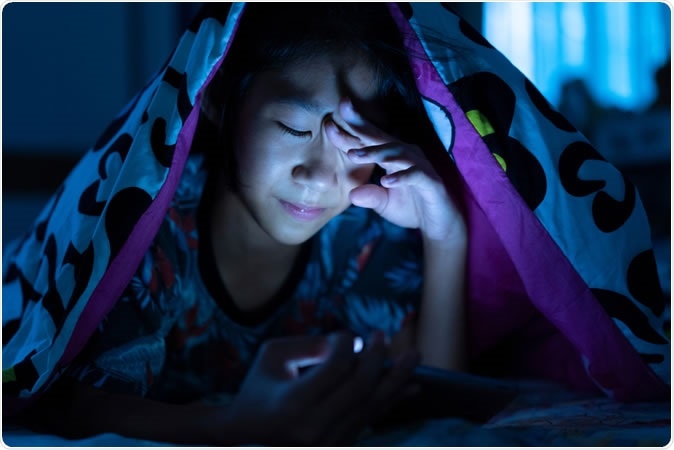
Eye of a fruit fly, Drosophila melanogaster, under a scanning electron microscope - Image Credit: Heiti Paves / Shutterstock
Natural light is essential for life, since this communicates a sense of time and the sleep-wake cycle to the human organism, regulating our bodily and metabolic processes. However, human beings have mastered the art of surrounding themselves with artificial night irrespective of their true bodily needs. Modern illumination is largely sourced from blue-light emitting light emission diodes (LEDs). These are lighting technologies that have been discovered quite late in man’s history. Their commercial availability is still more recent. As a result, we are using them without much knowledge of their long-term effects on human health.
These effects don’t seem to depend on retinal exposure to the blue light – in other words, you don’t need to see the light to be affected by it. Instead, blue light continues to produce these effects even when the flies are genetically modified so as to be born without eyes. Extended blue light exposure seems to act as a stressor, turning on specific stress-activated genes that cause aging.

Blue light can affect your sleep and potentially cause disease. - Image Credit: My Life Graphic / Shutterstock
The study and its outcomes
The researchers first exposed flies lacking pigment granules in their retinas, and which were therefore light-sensitive, to 12-hour LED light and darkness cycles, or in constant darkness. They found the second group had a 42% median longer survival. On repeating the experiment with wild-type flies, the same trend was seen.
Reduction in lifespan
The next test included two sets of pigment-negative flies both exposed to 12-hour shifts of LED light and darkness. LED light has a peak wavelength of about 460 nm, and therefore the first set was exposed to blue LED light while the second shift was exposed to white LED light with the blue wavelengths blocked. The intensity of the light from both sources remained the same. Compared with the flies kept in darkness, the median longevity was reduced by 50% and 4% in the blue light and blue-blocked light exposure groups, respectively.
When repeated in wildtype (non-mutated) flies, the median loss of longevity was 30% and 10% respectively. Even when the flies did not have eyes (due to gene manipulation) the lifespan went down by 37% and 42% for males and females. However, when they were kept in white light without blue wavelengths, their lifespan suffered by only 6% and 4%, compared to those kept in darkness.
Increase in the photon flux density, which measures the amount of light exposure, showed a corresponding rise in death rates. This indicates that the cause for the reduced lifespan in the above experiments is the blue light exposure.
Retinal damage
Blue light acts partially via the rhodopsin I receptor, which converts light to electrical impulses. Blue light appears to damage photoreceptor cells, causing retinal degeneration, which was visible in the flies that were kept under blue light: darkness cycles.
Brain degeneration
Brain cells also showed increased formation of vacuoles following exposure to blue light.
Aging due to stress response
Exposure to 12 hours of blue light also increased the expression of a number of genes involving in stress responses and aging. In flies kept in constant darkness, though, these did not show the same type of change even with a considerable lapse of time, suggesting that blue light exposure affects these genes much more strongly than aging does.
Moreover, when the exposure was only 5 days, these changes were not obvious, which may mean one of two things: either considerably more exposure is needed, or blue light acts in tandem with aging to upregulate the stress response. To test this, pigment-negative flies were kept in blue light/darkness shifts for their complete lifespan; for 25 days before shifting to complete darkness; or for 30 days before shifting to complete darkness.
The lifespan in the second group lived almost as long as those kept in darkness throughout, that is, they recovered their lifespan, except for a few flies that died within a few days. However, flies in the third group tended to die within a few days, without responding to the shift to darkness. Median survival in the third and first group was 34 and 33 days respectively.
The reverse was also done: after putting flies in darkness for 30 days, they were exposed to blue light: darkness shifts. The median survival was only 21 days after the shift. On the other hand, young flies kept under light: darkness conditions survived for a median of 34 days. This could mean that cumulative damage due to blue light can be arrested once the stress is removed if it is sublethal. Secondly, older flies are damaged faster by blue light. The average reduction in lifespan ranged from 5% to 15%.
Conclusion
Blue light may cause brain degeneration as well as retinal damage, and reduce the lifespan. The findings agree with other older studies in mice, flies and human skin cells, that show increased generation of reactive oxygen species that cause cellular damage, following blue light exposure. This could be due to induced stress responses. However, changing from blue light exposure to darkness at an early age, and reducing the cumulative exposure to blue light, can prevent the increase in mortality. This study in flies can help conclude that LED blue light is a major source of environmental stress and the effects become more and more harmful with cumulative exposure. Humans are constantly exposed to blue light from flat screens, light bulbs and smartphones, among other light sources, and scientists think that night shift workers have a higher risk of cancer due to their longer exposure to artificial light. Using devices to block out blue light could be one way to minimize the harm.
Of course, there’s a long way from these findings in fruit flies to saying human brains are being eaten away by smartphones. However, they should be taken as a basis to do more research on an urgent basis so that potentially harmful lighting may be averted.
Researcher Eileen Chow says, “Human lifespan has increased dramatically over the past century as we've found ways to treat diseases, and at the same time we have been spending more and more time with artificial light. As science looks for ways to help people be healthier as they live longer, designing a healthier spectrum of light might be a possibility, not just in terms of sleeping better but in terms of overall health.”
Journal reference:
Daily blue-light exposure shortens lifespan and causes brain neurodegeneration in Drosophila, Trevor R. Nash, Eileen S. Chow, Alexander D. Law, Samuel D. Fu, Elzbieta Fuszara, Aleksandra Bilska, Piotr Bebas, Doris Kretzschmar & Jadwiga M. Giebultowicz, npj Aging and Mechanisms of Disease volume 5, Article number: 8 (2019), https://www.nature.com/articles/s41514-019-0038-6